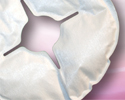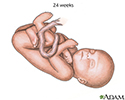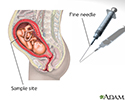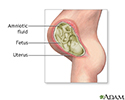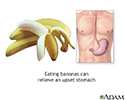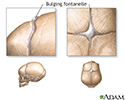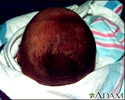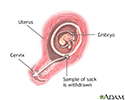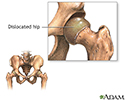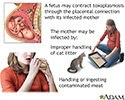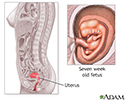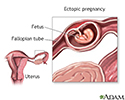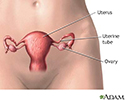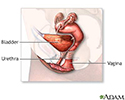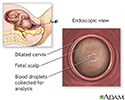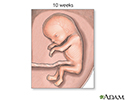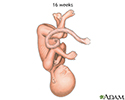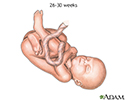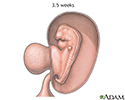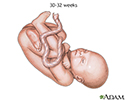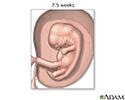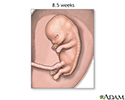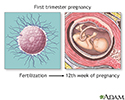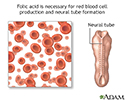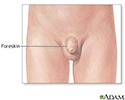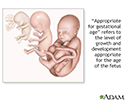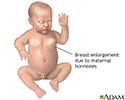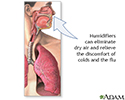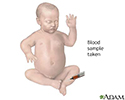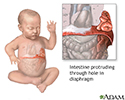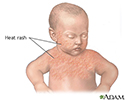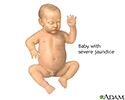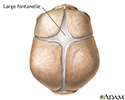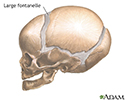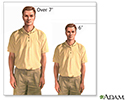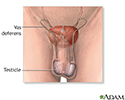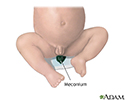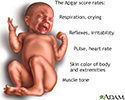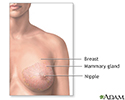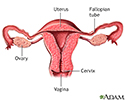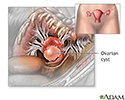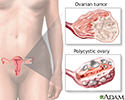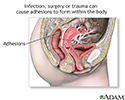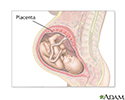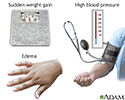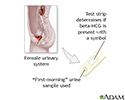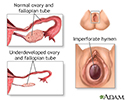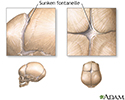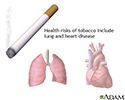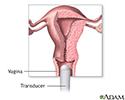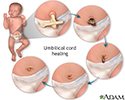Multimedia Gallery



CPR - infant - series
Check for breathing
1. Check for responsiveness. Shake or tap the infant gently. See if the infant moves or makes a noise. Shout, "Are you OK?"
2. If there is no response, shout for help. Send someone to call 911. Do not leave the infant yourself to call 911 until you have performed CPR for about 2 minutes.
3. Carefully place the infant on their back. If there is a chance the infant has a spinal injury, two people should move the infant to prevent the head and neck from twisting.
CPR - infant - series
Check for breathing
1. Check for responsiveness. Shake or tap the infant gently. See if the infant moves or makes a noise. Shout, "Are you OK?"2. If there is no response...
CPR - infant - series
Chest compressions
4. Perform chest compressions:
- Place 2 fingers on the breastbone -- just below the nipples. Make sure not to press at the very end of the breastbone.
- Keep your other hand on the infant's forehead, keeping the head tilted back.
- Press down on the infant's chest so that it compresses about 1/3 to 1/2 the depth of the chest.
- Give 30 chest compressions. Each time, let the chest rise completely. These compressions should be FAST and hard with no pausing. Count the 30 compressions quickly: "1,2,3,4,5,6,7,8,9,10,11,12,13,14,15,16,17,18,19,20,21,22,23,24,25,26,27,28,29,30, off."
CPR - infant - series
Chest compressions
4. Perform chest compressions:Place 2 fingers on the breastbone -- just below the nipples. Make sure not to press at the very end of the breastbone.K...
CPR - infant - series
Infant not breathing
5. Open the airway. Lift up the chin with one hand. At the same time, push down on the forehead with the other hand.
6. Look, listen, and feel for breathing. Place your ear close to the infant’s mouth and nose. Watch for chest movement. Feel for breath on your cheek.
7. If the infant is not breathing:
- Cover the infant's mouth and nose tightly with your mouth.
- Alternatively, cover just the nose. Hold the mouth shut.
- Keep the chin lifted and head tilted.
- Give 2 breaths. Each breath should take about a second and make the chest rise.
8. Continue CPR (30 chest compressions followed by 2 breaths, then repeat) for about 2 minutes.
9. After about 2 minutes of CPR, if the infant still does not have normal breathing, coughing, or any movement, leave the infant to call 911.
10. Repeat rescue breathing and chest compressions until the infant recovers or help arrives.
If the infant starts breathing again, place them in the recovery position. Periodically re-check for breathing until help arrives.
CPR - infant - series
Infant not breathing
5. Open the airway. Lift up the chin with one hand. At the same time, push down on the forehead with the other hand.6. Look, listen, and feel for bre...
Review Date: 1/8/2025
Reviewed By: Jesse Borke, MD, CPE, FAAEM, FACEP, Attending Physician at Kaiser Permanente, Orange County, CA. Also reviewed by David C. Dugdale, MD, Medical Director, Brenda Conaway, Editorial Director, and the A.D.A.M. Editorial team.
1. Check for responsiveness. Shake or tap the infant gently. See if the infant moves or makes a noise. Shout, "Are you OK?"
2. If there is no response, shout for help. Send someone to call 911. Do not leave the infant yourself to call 911 until you have performed CPR for about 2 minutes.
3. Carefully place the infant on their back. If there is a chance the infant has a spinal injury, two people should move the infant to prevent the head and neck from twisting.
4. Perform chest compressions:
- Place 2 fingers on the breastbone -- just below the nipples. Make sure not to press at the very end of the breastbone.
- Keep your other hand on the infant's forehead, keeping the head tilted back.
- Press down on the infant's chest so that it compresses about 1/3 to 1/2 the depth of the chest.
- Give 30 chest compressions. Each time, let the chest rise completely. These compressions should be FAST and hard with no pausing. Count the 30 compressions quickly: "1,2,3,4,5,6,7,8,9,10,11,12,13,14,15,16,17,18,19,20,21,22,23,24,25,26,27,28,29,30, off."
5. Open the airway. Lift up the chin with one hand. At the same time, push down on the forehead with the other hand.
6. Look, listen, and feel for breathing. Place your ear close to the infant’s mouth and nose. Watch for chest movement. Feel for breath on your cheek.
7. If the infant is not breathing:
- Cover the infant's mouth and nose tightly with your mouth.
- Alternatively, cover just the nose. Hold the mouth shut.
- Keep the chin lifted and head tilted.
- Give 2 breaths. Each breath should take about a second and make the chest rise.
8. Continue CPR (30 chest compressions followed by 2 breaths, then repeat) for about 2 minutes.
9. After about 2 minutes of CPR, if the infant still does not have normal breathing, coughing, or any movement, leave the infant to call 911.
10. Repeat rescue breathing and chest compressions until the infant recovers or help arrives.
If the infant starts breathing again, place them in the recovery position. Periodically re-check for breathing until help arrives.



Animations
- Breast engorgement
- Cell division
- Cesarean section
- Conception - general
- Conception - pregnancy
- Conception of identical twins
- C-section
- Early labor
- Egg cell production
- Egg production
- Endometriosis
- Fetal ear development
- Formation of twins
- Human face formation
- Infant formulas
- Kids - How big is the baby?
- Kids - How does the baby co...
- Kids - Is it a girl or boy?
- Kids - Umbilical cord
- Kids - Where do babies come...
- Newborn jaundice
- NICU consultants and suppor...
- Ovulation
- Placenta delivery
- Placenta formation
- Preeclampsia
- Pregnancy
- Pregnancy care
- Sperm production
- Sperm release pathway
- Storing breast milk
- The role of amniotic fluid
- Twin-to-twin transfusion sy...
- Ultrasound
- Vaginal delivery
Illustrations
- 24-week fetus
- Abnormal discharge from the...
- Abnormal menstrual periods
- Absence of menstruation (am...
- Amniocentesis
- Amniocentesis
- Amniotic fluid
- Amniotic fluid
- Anatomy of a normal placenta
- Antibodies
- Baby burping position
- Bananas and nausea
- Blood cells
- Blood test
- Breast infection
- Breastfeeding
- Bulging fontanelles
- Candida - fluorescent stain
- Caput succedaneum
- Cesarean section
- Cesarean section
- Cesarean section
- Childbirth
- Chorionic villus sampling
- Congenital hip dislocation
- Congenital toxoplasmosis
- Crying - excessive (0 to 6 ...
- Delivery presentations
- Developmental milestones
- Early weeks of pregnancy
- Ectopic pregnancy
- Emergency Childbirth
- Emergency Childbirth
- Endocrine glands
- Endometriosis
- Endometritis
- Erythroblastosis fetalis - ...
- Female breast
- Female reproductive anatomy
- Female reproductive anatomy
- Female reproductive anatomy...
- Female urinary tract
- Fetal blood testing
- Fetal head molding
- Fetus at 10 weeks
- Fetus at 12 weeks
- Fetus at 16 weeks
- Fetus at 26 to 30 weeks
- Fetus at 3.5 weeks
- Fetus at 30 to 32 weeks
- Fetus at 7.5 weeks
- Fetus at 8.5 weeks
- First trimester of pregnancy
- Folic acid
- Folic acid benefits
- Folic acid source
- Follicle development
- Fontanelles
- Foreskin
- Gestational ages
- Gestational diabetes
- Gonadotropins
- Head circumference
- Heat rash
- Height/weight chart
- Hormonal effects in newborns
- Humidifiers and health
- Hysterectomy
- Infant blood sample
- Infant care following delivery
- Infant diaphragmatic hernia
- Infant heat rash
- Infant intestines
- Infant jaundice
- Infantile reflexes
- Influenza vaccines
- Intraductal papilloma
- Intrauterine transfusion
- Jaundiced infant
- Large fontanelles
- Large fontanelles (lateral view)
- Macrosomia
- Male reproductive anatomy
- Male reproductive anatomy
- Male urinary tract
- Mammary gland
- Meconium
- Morning sickness
- Moro reflex
- Newborn head molding
- Newborn test
- Normal female breast anatomy
- Normal uterine anatomy (cut...
- Ovarian cyst
- Ovarian hypofunction
- Overproductive ovaries
- Pelvic adhesions
- Pelvic laparoscopy
- Placenta
- Placenta
- Placenta
- Placenta previa
- Polyhydramnios
- Preeclampsia
- Pregnancy test
- Primary amenorrhea
- Primary infertility
- Secondary amenorrhea
- Secondary infection
- Side sectional view of fema...
- Single palmar crease
- Skull of a newborn
- Slit-lamp exam
- Sperm
- Stein-Leventhal syndrome
- Sunken fontanelles (superio...
- Tobacco health risks
- Transvaginal ultrasound
- Ultrasound in pregnancy
- Ultrasound, color - normal ...
- Ultrasound, normal fetus - ...
- Ultrasound, normal fetus - ...
- Ultrasound, normal fetus - ...
- Ultrasound, normal fetus - face
- Ultrasound, normal fetus - ...
- Ultrasound, normal fetus - foot
- Ultrasound, normal fetus - ...
- Ultrasound, normal fetus - ...
- Ultrasound, normal fetus - ...
- Ultrasound, normal fetus - ...
- Ultrasound, normal placenta...
- Ultrasound, normal relaxed ...
- Umbilical cord healing
- Uterus
- Vaginal bleeding during pre...
- Well baby visits
- Yeast infections

 Bookmark
Bookmark



























